HOME GUARD MEMORIES AND INFORMATION - OTHER COUNTIES M-S - RENFREWSHIRE
1st RENFREWSHIRE & BUTE BATTN.
and
William MacFarlane Ferguson
(and his role in one of the 20th Century's greatest mysteries)
|
This is a page within the www.staffshomeguard.co.uk website. To see full contents, go to SITE MAP.
At the beginning of WW2 William MacFarlane Ferguson (1911-1985) was a Marine Draughtsman with the firm of Drysdale & Co. Ltd. at Yoker near Clydebank, manufacturers of marine centrifugal pumps. To his considerable irritation he was turned down by the services on medical grounds: a hip problem was regarded as sufficient reason for rejection although his later role in the Home Guard casts some doubt on the quality of that assessment. One must assume that he would in any case have encountered difficulties in joining up in view of his professional duties which fell clearly into the category of "reserved occupation".
And so William Ferguson volunteered for the Home Guard.
The unit which William joined was part of the 1st Renfrewshire & Bute Battalion whose H.Q was at Greenock. For some or all of his service he was in a detachment known as "Guides" in which he held the rank of corporal: these were men with a knowledge of the local area and terrain whose job, in the event of invasion, would be to conduct senior, visiting personnel to their destinations whilst avoiding the use of public roads. As William used to tell his son in later years as they tramped over field and moor, furthering the youngster's knowledge of the local geography: "If anything goes wrong the first thing they'll do is close the roads".
Here he is, on an unknown date and at a high point in their territory, together with another corporal and an older man who is almost certainly their Commanding Officer.
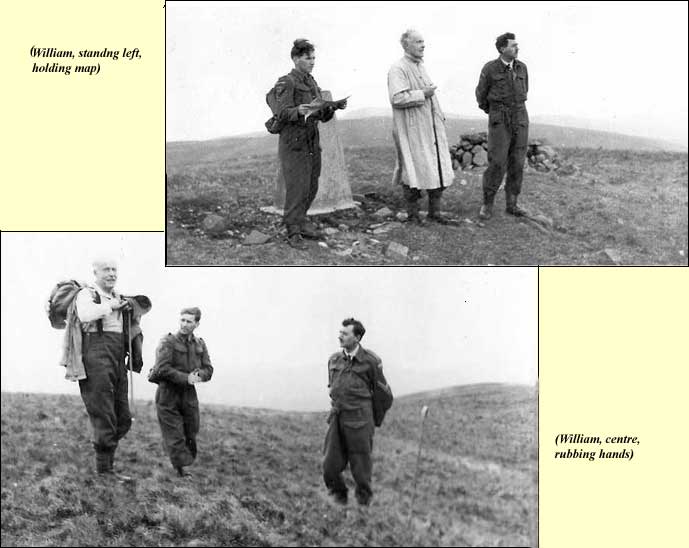
William was also a keen amateur photographer and this fact, together with the particular role he played, means that he left behind a wealth of fascinating images of his Home Guard service and of the comrades with whom he served. Unlike many Home Guard group photographs which are usually located outside village halls or in local parks and celebrate formal occasions such as HG anniversaries, these all record the men in less cosy surroundings, on bleak moorland or in forest, as they go about their work. They are displayed on this page.
Here on a sunny May 3rd 1942 the group take a breather during what is described on the rear of the photograph as a "cross-country tour". William is in the centre of the picture, the one man of the three not looking at the camera. 
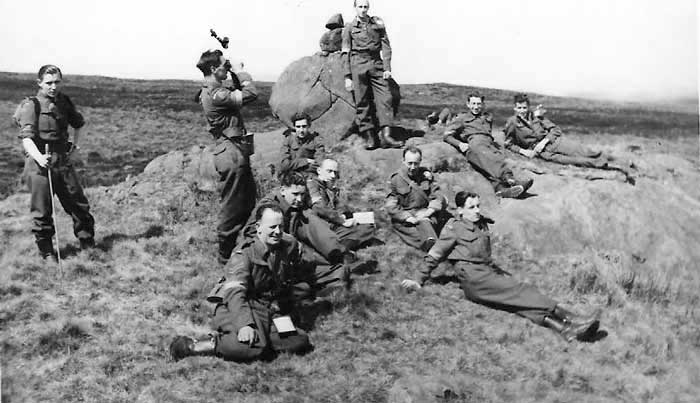
Just a year earlier William, and probably some of the other men in these pictures, found themselves caught up in something quite extraordinary. This is what happened.
The Night of 10th May 1941
On the night of 10th May 1941 William Ferguson was involved in an unusual incident which rapidly developed into one of the greatest unexplained mysteries of the 20th century.
Reports reached the Home Guard of the appearance of a German parachutist being held in a farmhouse at Eaglesham. A ploughman, David MacLean, had heard an explosion and seen a parachute descending. He found and apprehended the parachutist, a German officer with an injured ankle, taking him to his mother's farmhouse, Floors Farm, where, of course, a cup of tea was offered. The officer introduced himself as Hauptmann Alfred Horn and said that he had an urgent message for the Duke of Hamilton.
A small Home Guard group set out for the farmhouse, comprising an officer, William Ferguson and one or two other men. On their arrival William's officer who was a German speaker (and who almost certainly appears in several images on this page) questioned the prisoner for some time. At first Horn continued to claim that identity but at some stage -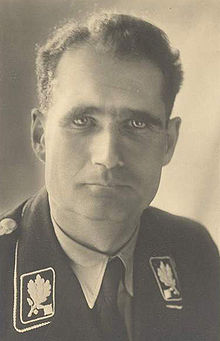 now or later, it is not entirely clear when - his real identity emerged: Rudolf Hess, Deputy Leader of the Nazi Party and in that role second only to Adolf Hitler himself. He had left Augsburg at 5.45 p.m. that evening in a ME 110 fitted with long-range fuel tanks, navigated himself the 1000-odd miles to the Duke of Hamilton's country retreat, Dungavel House near Strahaven in South Lanarkshire where he had hoped to land on the Duke's own airstrip, had failed to do so and had finally bailed out, injuring his ankle in the process. His aim, so he said, was to discuss with the Duke ways of bringing about peace between Great Britain and Germany, so that, presumably, Germany could concentrate on dealing with the Soviet Union which was to be invaded during the following month. now or later, it is not entirely clear when - his real identity emerged: Rudolf Hess, Deputy Leader of the Nazi Party and in that role second only to Adolf Hitler himself. He had left Augsburg at 5.45 p.m. that evening in a ME 110 fitted with long-range fuel tanks, navigated himself the 1000-odd miles to the Duke of Hamilton's country retreat, Dungavel House near Strahaven in South Lanarkshire where he had hoped to land on the Duke's own airstrip, had failed to do so and had finally bailed out, injuring his ankle in the process. His aim, so he said, was to discuss with the Duke ways of bringing about peace between Great Britain and Germany, so that, presumably, Germany could concentrate on dealing with the Soviet Union which was to be invaded during the following month.
Little more than the bare facts about this episode are clear. The questions and theories have proliferated over the years: did Hitler know about it? Was Hess lured into a British Secret Service trap? Was he responding to overtures from a peace-seeking British group? What were the precise proposals and what was really going on? Why the Duke of Hamilton? Why wasn't Hess's aircraft intercepted by the RAF? Or by the Luftwaffe? Was he mad, as the Nazi propaganda machine immediately claimed? And even, was this man, or the man who reappeared much later, truly Hess or a planted imposter? These questions continue to seek answers today just as they did on that May evening nearly 70 years ago when William's C.O. was probably asking some of them.
In due course Rudolf Hess was handed over by William's detachment to others and disappeared from public view for the rest of the war and beyond. And that is how he would remain until he finally saw light of day again in the dock at the Nuremberg War Crime Trials in 1946. On the very night of his capture the secrecy blanket had come down and has never been properly lifted.
Before the Home Guard men dispersed for the night, their historic duty done, and before he had gone off to be debriefed and almost certainly sworn to indefinite silence, the C.O. chatted to William about his conversation with the mysterious captive. One can only speculate whether during that chat comments were made and facts emerged which would have added weight to one of the well-known theories - or even created a completely new one to intrigue historians as yet unborn.
As for William, still smarting at his inability to join the Regular Army, he would say in later years that during the period 1939-1945 he had only ever managed to set eyes on one single German. We must hope that he found some consolation, however, in the thought that the particular German he had seen was at that moment, after Hitler and Göring, still the third most powerful man in the Third Reich!
Much more information on this mystery is to be found in many books devoted to the subject and in several web pages; just two of the latter can be seen here and here.
|
Both before and after this extraordinary incident, Home Guard duties continued as normal for William Ferguson and his comrades. He does not appear in the following group but he may well have been the man behind the camera. We note from the sign that the Gavrocks Estate is for sale; this was located at the southern end of Loch Thom. 
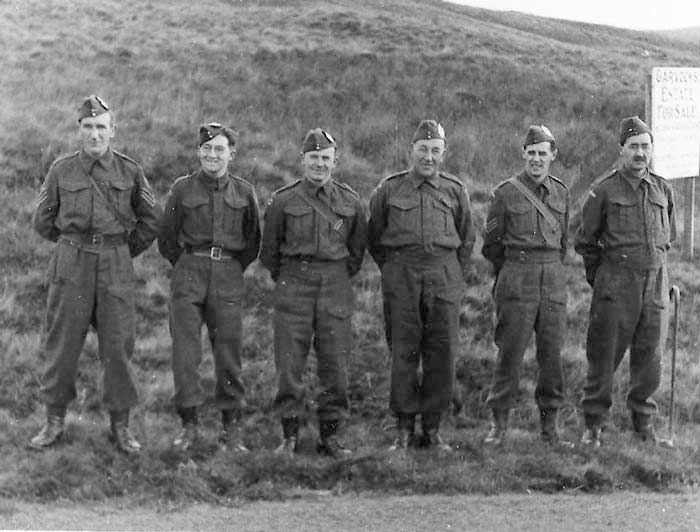
The group is recorded again, on 15th August 1943. William is third from the left, back row. From his ribbon we can see that the officer is clearly a survivor from the Great War; looking at his age, he may even have been involved in earlier conflicts. 
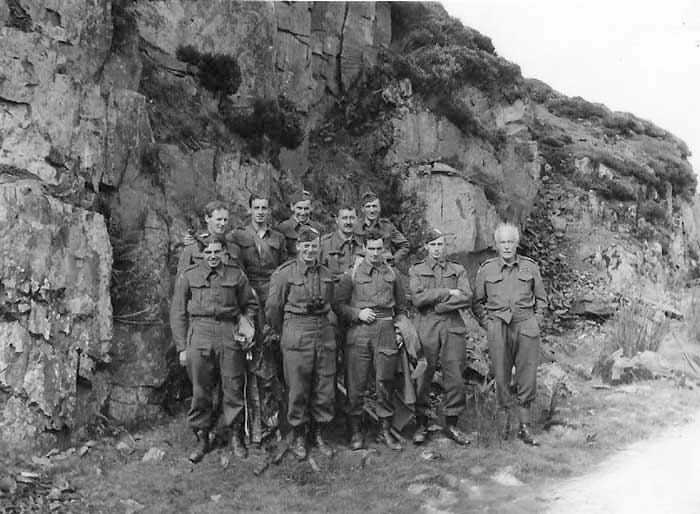
But of course the Home Guard was not just an occupation for warm sunny days. Here the group, in greatcoat, gloves and headgear, pause in their winter activity on exposed moorland to face the camera. William is on the extreme right and does not seem to be finding it all too much of an ordeal. 
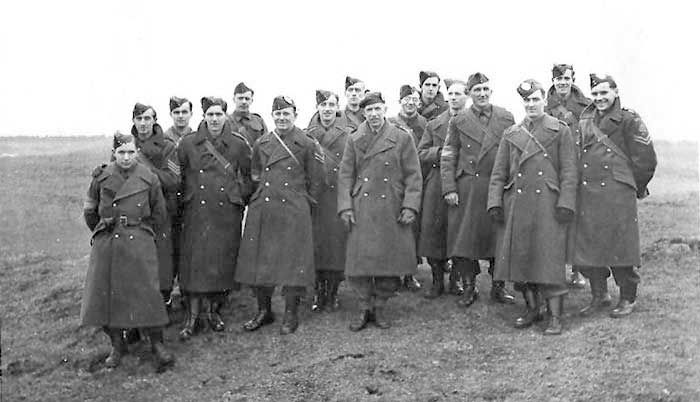
Most of the men seen in this and other photographs would have come from the villages and farms around Langbank, Bishopton, Kilmacolm and Bridge of Weir.
It was obviously not all a matter of Shank's pony. Here William, holding his cap in his hand, is photographed on a moorland track by the fifth member of the group, having presumably arrived in some comfort. 
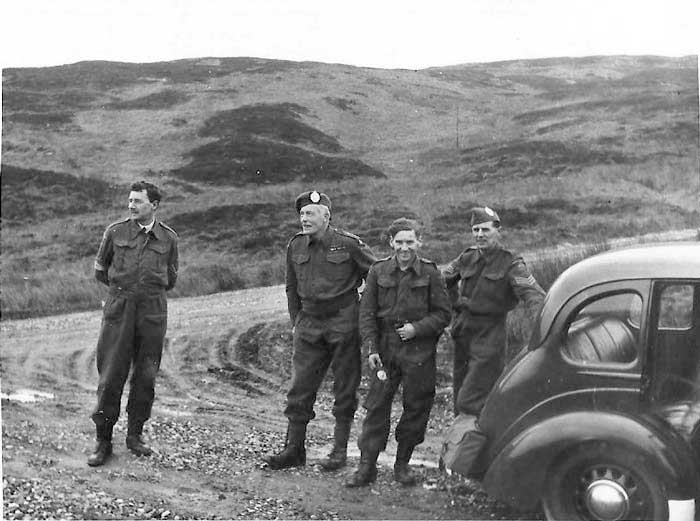
William, second from the right below, is gazing into the far distance through binoculars. This image is annotated "Learmont Forest" and one would assume that it was taken, like all the others, in Renfrewshire or nearby; but the only place of that name so far identified is in County Londonderry, Northern Ireland, a venue which is hardly likely for members of the Scottish unit. 
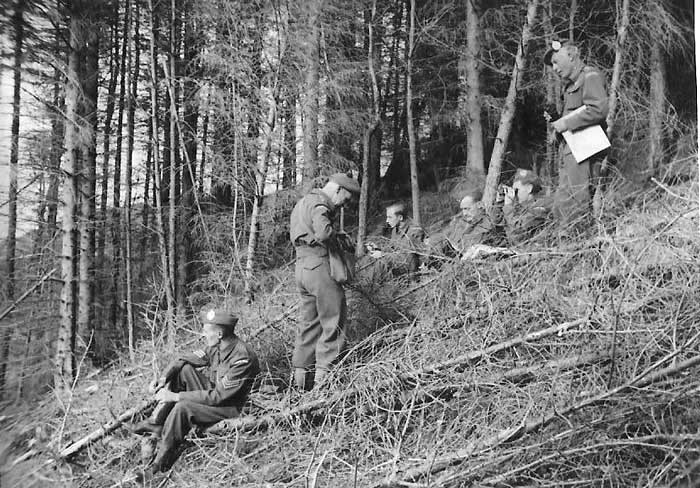
The final image may have been taken by William for he does not appear in it. It shows some of the more mature officers of the Battalion. One of the men in civvies seems the be William's C.O. and the other someone we have not seen before - perhaps a local landowner. The staff car on the left is worthy of note: a splendid relic of the 1920s with "1st BATT. R & B HOME GUARD" painted on its door and standing in stark contrast to its sleek, modern counterpart to the right. The location is Routenburn Bridge, on the east coast of the Firth of Clyde near the town of Largs. 
. 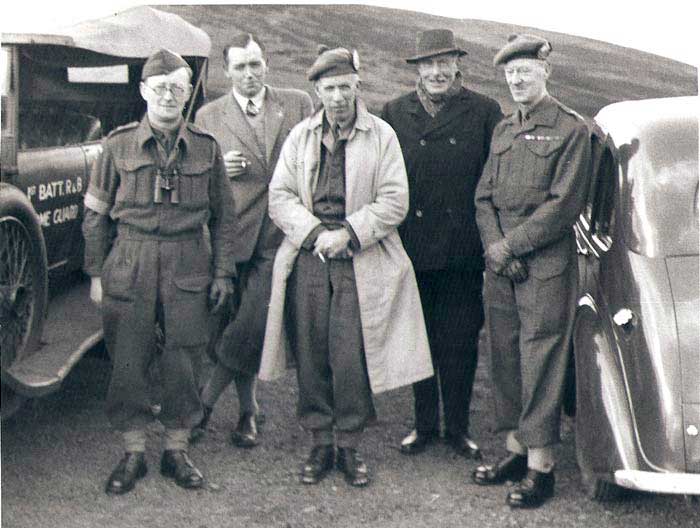
Eventually when it was all over and the Home Guard was stood down in December 1944, members of the Battalion dispersed to concentrate on their familes and jobs - in farms, on estates, in factories and offices and ship-building yards, or, in William's case, engineering Drawing Offices. But the bonds of comradeship created in those years of discomfort and long unpaid hours of physical and mental effort were not so easily broken. Just a single record remains of the continuing links: a reunion "bash" as William remembered it, one snowy day in 1945, when they came together again. William is second right, front row, still cheerful. The pewter mug which William received on this occasion was engraved "To remind you of days in the hills with the Guides"; it is still retained and treasured within the family.
Does the image perhaps record the moment when these dedicated and patriotic men were reunited for the final time? 
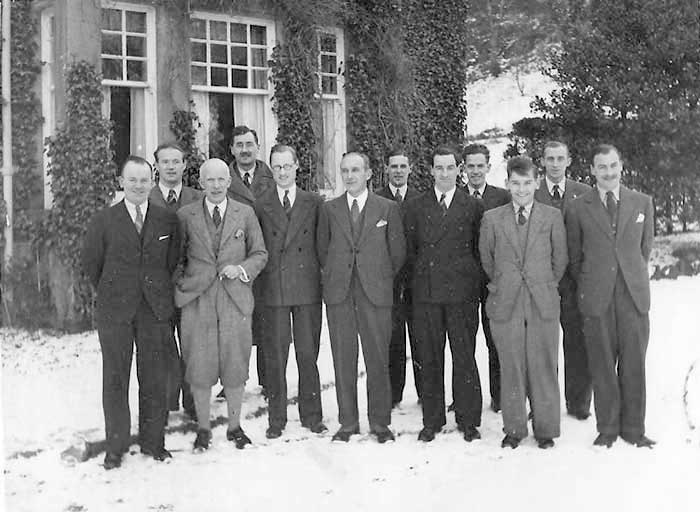
***********